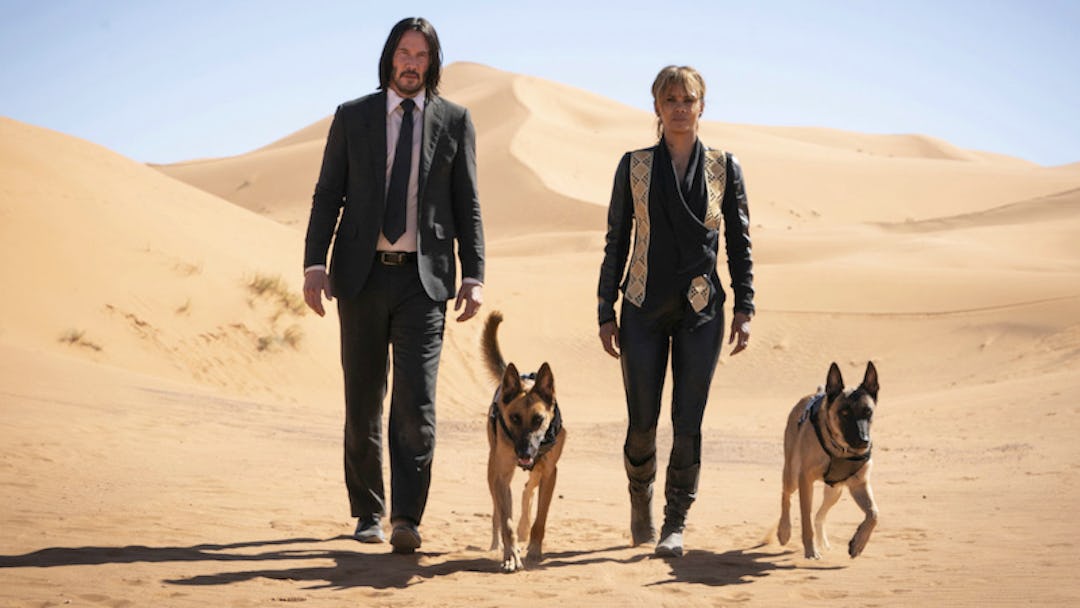There’s a fight scene late in John Wick: Chapter 3 – Parabellum, one of several such scenes wrapped up into the gleeful orgy of gunplay and hand-to-hand combat that takes up the bulk of its third act, in which the title character finds himself taking on two men in a room lined with several tall glass cases, each one holding some sort of (we presume) priceless artifact. Early in the scene, one of Wick’s combatants kicks him directly into a glass case, which (unsurprisingly) smashes loudly into pieces. Wick, being John Wick, staggers back up on to his feet for more – and is promptly kicked into another one. And on it goes, up and down, until it becomes clear that they’re just gonna kick him into every damn one of those glass cases, one right after the other. The bit becomes funny for the same reason, and in the same way, that it’s funny when Sideshow Bob steps on those rakes; by the end, you’re laughing in sheer appreciation of the filmmakers, and of their dedication to going all the way with it.
All of which is a long way of saying that Chapter 3 is a blast not only in the customary boom-smash, bang-bang, run-and-gun way of most good action movies (though it certainly is that), but because of the style and wit of the execution. That style extends to the world that surrounds its action beats, by now as intricate and ornate as any of its concurrent “cinematic universes” (but a helluva lot more fun), overloaded with sly details about this world of paid assassins, the societies into which they’re organized, the establishments in which they dwell, and, most of all, the rules which they must obey.
Chapter 2 ended with John Wick (played again with taciturn determination by Keanu Reeves) breaking one of those rules by murdering one of his colleagues on the consecrated grounds of New York’s Continental Hotel, where no business may be conducted. It ended with a cliffhanger, finding Wick and his dog on the run, with a $14 million bounty on his head, and a “disavowal” extending him none of the protections of “the High Table,” the governing body of contract killers. “Do not make the mistake of thinking you exist outside the rules,” explains “The Adjudicator” (Asia Kate Dillon). “No man does.”
If the second movie went ornate, in many ways the third strips it back down: because it’s the second half of a cliffhanger, it can basically be what you want it to be, which is a movie about a whole bunch of guys trying to kill John Wick, and (spoiler alert? I guess?) failing. It only falters when it takes its eye off that ball, with a sagging middle section in which Wick seeks passage to Casablanca (yes, really) to appeal his disavowal, which leads to a few too many more of the series’ awkward scenes of announcement and exposition – “John Wick, what wickedness would cause you to darken my door,” that kinda thing.
More detrimentally, we end up with a couple of concurrent action sequences back in New York in which Wick isn’t even present, and this viewer was totally unmoved by them – if John’s not there, the emotional stakes are nil. Yes, yes, it’s quite silly to go on about “emotional stakes” in a franchise in which the protagonist is, quite literally, unkillable (he’s called “The Boogeyman,” as if he’s the villain in a Halloween or Candyman movie, and not the hero of this one). But from the beginning, these films have been fueled by his sense of loss, by righteous indignation and misplaced/suppressed fury; questions of grief, depression, and suicide are not uncommon to this character (and become even more pointed this time around).
Most of John Wick’s audience isn’t there for that stuff, of course, but for the action, and it does not disappoint. Once again, the most striking element of the fight scenes is their comic timing, in both choreography and editing, and their situational ingenuity. The influence of Jackie Chan and Buster Keaton (who was, lest we forget, the first face seen in Chapter 2) continues to dominate, and as in the set pieces of those masters, each big Wick sequence introduces a new variable – an animal, a vehicle, a location, a weapon, whatever – and runs with it.
And as with a Chan or Keaton sequence, one gets the sense that every possible variation of that variable was worked through, that a bunch of smart people sat in a room and tried to top each other with ideas and gags. (The director is Chad Stahelski; the screenwriters are Derek Kolstad, Shay Hatten, Chris Collins, and Marc Abrams). The gore, though convincing, also somehow feels like an extension of the slapstick, the way Sam Raimi’s does. You laugh in these scenes, not because someone died, or because it’s cruel. You laugh because they’re getting away with it – and doing so in long, elegant, mind-boggling takes, less like the choppy action of the Bay era, and more like the full-body photography of an MGM musical.
The scrappy energy of the Wick movies is what makes them special – that and Mr. Reeves, who has quietly turned into Clint Eastwood, shaking off his earlier and occasionally embarrassing attempts at expanding his range, and instead focusing on this specific thing that he does very, very well. His sheer athleticism is astonishing (keep in mind, this man turns 55 in September), but what’s more impressive is his gravitas. He’s doing the most insane, impossible things in these movies, but the way he growls and glowers and shakes it off and gets back up somehow makes it believable. And then they just throw him into another damn glass case.
“John Wick: Chapter 3 – Parabellum” is out Friday.
